 W
WThe British Ceylon period is the history of Sri Lanka between 1815 and 1948. It follows the fall of the Kandyan Kingdom into the hands of the British Empire. It ended over 2300 years of Sinhalese monarchy rule on the island. The British rule on the island lasted until 1948 when the country regained independence.
 W
WCeylon was the British Crown colony of present-day Sri Lanka between 1796 and 4 February 1948. Initially, the area it covered did not include the Kingdom of Kandy, which was a protectorate, but from 1817 to 1948 the British possessions included the whole island of Ceylon, now the nation of Sri Lanka.
 W
WThe Governor of Ceylon was the representative in Ceylon of the British Crown from 1795 to 1948. In this capacity, the governor was president of the Executive Council and Commander-in-Chief of the British Forces in Ceylon. The governor was the head of the British colonial administration in Ceylon, reporting to the Colonial Office.
 W
WSir James Emerson Tennent, 1st Baronet FRS, born James Emerson, was a British politician and traveller born in Ireland. He was elected a Fellow of the Royal Society on 5 June 1862.
 W
WMuhandiram was a post in the native headmen system in the lower-country of Ceylon during the colonial era. It was awarded as a title of honor until suspension of Ceylonese honours in 1956.
 W
WNative headmen system was an integral part of the administration of the island of Ceylon under the successive European colonial powers, namely the Portuguese Empire, the Dutch East India Company and the British Empire. Native headmen or leaders were appointed by the European colonial administrators to function as intermediates between the Europeans and the native populous. During different periods through this system these headmen functioned in military, policing, administrative and ceremonial capacities. They served as translators, revenue collectors and wielded quasi-judicial powers. Much of the system evolved and changed over time until some of the last vestiges of it were removed in the post-independent Ceylon. The members of this group formed a unique social group called the Sri Lankan Mudaliyars and associated with older Radala caste.
 W
WDeekirikevage Saradiel widely famous as Utuwankande Sura Saradiel,translation:Saradiel the Hero of Mountain Utuwan is a Ceylonese gang leader and bandit who became a legendary figure in Sri Lanka known as the "Robin Hood of Sri Lanka". Some Sri Lankan scholars place him in the context of regional insurgencies of against British Colonial rule rather than a manifestation of local lawlessness or economic justice. Due to superstition he was believed to have the power of not being seen and that he was bullet proof. Many believe that this is because he had Henaraja "yantra" on his arm which lent him such powers.
 W
WHenry Charles Sirr (1807-1872) was a British lawyer, diplomat and writer. He graduated at Trinity College, Dublin and became a barrister at Lincoln's Inn, London. Eventually he went into government service, working as Deputy Queen's Advocate for the Southern Circuit of Ceylon in the mid-19th century.
 W
WThe Sri Lankan independence movement was a peaceful political movement which was aimed at achieving independence and self-rule for the country of Sri Lanka, then British Ceylon, from the British Empire. The switch of powers was generally known as peaceful transfer of power from the British administration to Ceylon representatives, a phrase that implies considerable continuity with a colonial era that lasted 400 years. It was initiated around the turn of the 20th century and led mostly by the educated middle class. It succeeded when, on 4 February 1948, Ceylon was granted independence as the Dominion of Ceylon. Dominion status within the British Commonwealth was retained for the next 24 years until 22 May 1972 when it became a republic and was renamed the Republic of Sri Lanka.
 W
WWariyapola Sri Sumangala was a Buddhist monk who lived in the early 19th century in Sri Lanka. He was an Anunayaka of the Asgiriya Chapter. Sri Sumangala is known for taking down the Union Jack and re-hoisting the Sinhalese lion flag, before the convention that handed over control of the island to the British in 1815. Later during the rebellion of 1818, he removed the Tooth Relic of the Buddha from the Temple of the Tooth, and handed it over to the leaders of the rebellion. He was arrested and convicted for treason the same year.
 W
WThe vidane was an influential post in the native headman system in Ceylon during the colonial era. Appointed by the government agent. The holder had much control over the people of the area and wielded quasi-judicial powers since he was responsible to keep the peace, carry out revenue collection and assist in judicial functions.